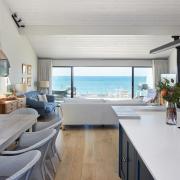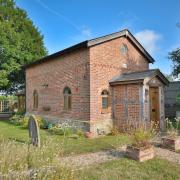Looking at the clean lines created out of wood and glass, it would be hard to imagine that the ultra-modern house near Chichester that seems to float above a natural swimming pool was forged in the owner’s mind when he was just a boy living on a farm.
Daniel Rowland was walking hand-in-hand with his mother on the family farm that had become organic two years earlier. Suddenly he heard owls calling across the fields to each other for the first time as they had vanished from the area years before.
Allowing nature to reclaim the land has brought back the wildlife and the farm was thriving. In that moment Daniel, who would grow up to become an architect, knew that he would always put nature and the natural world at the centre of his designs – and his beautiful biophilic house is testament to that ideology.
Daniel, who lives in the house on a 1.5 acre plot in Bosham with interior designer wife Nina, tells Sussex Life: ‘If you get the design right, you can sit in a built environment that is in unison with the natural environment. In the evenings, we can watch the bats swoop down and eat all of the insects. We see toads, frogs and newts come out. The best way of watching nature is letting nature come to you rather than searching for it.’

However, the benefits go far beyond providing a stunning home that was featured on Channel 4’s popular TV show Grand Designs and a constant wildlife documentary on his doorstep.
Incorporating the natural world into the designs for buildings has benefits not only for nature but for our own health and mental wellbeing: reducing stress, boosting positivity and impacting our mood as well as helping us to sleep better.
Daniel has used natural materials with patina and texture on the inside and exterior of the house and landscaping to introduce gentle, natural forms onto the previously barren site with a stagnant pond.
Blending them together was key to creating a family home. ‘We always used to laugh about these incredibly modernist spaces where if one of the lines is out of place or something is on a worktop, it throws off the geometry of the design,’ he says. ‘Very few people realistically can live like that. You can see things on Instagram that sell this ideal to you but the reality is, especially if you have a family, that it's unrealistic but also not a very healthy way of living.’

He is now an ardent fan of biophilic design, using it at work at his award-winning architectural practice Studio Fuse, which creates holistic buildings nestle seamlessly into their environment.
‘In every single project, rather than just bringing in lots of concrete, you should be thinking about improving the ecology and biodiversity around you,’ he explains. ‘We need to reconnect with nature after stampeding all over it. Our health is intrinsically linked to it.’
Interior designer and author Oliver Heath agrees. He has built his Brighton practice around the concept. A regular on TV, Heath was the ever-patient foil to Lawrence Llewelyn-Bowen’s flamboyance on TV’s decorating programme Changing Rooms.
As well as writing books, Heath guides clients through how to incorporate biophilic design into their spaces, offering courses on how this design philosophy can be woven into any home.

‘Elements of biophilic design have been here throughout human evolution for hundreds of thousands of years,’ he explains. But in his book The 9 Foundations of a Healthy Building he explains how biophilic design can help combat stress while introducing natural elements that help us reconnect with the natural world.
He argues that spaces devoid of natural cues have a negative impact on our wellbeing – something that suddenly came into sharp focus during the pandemic when we were forced to stay home. ‘Without offering a diversity of sensory experiences within them, spaces can have a negative impact on our physical and mental wellbeing, especially when we are carrying out stressful roles within them,’ Oliver says.
This has echoes of the philosophies of the Arts and Crafts movement in which natural forms were incorporated into homes - most famously William Morris’ intricate, botanical wallpapers – after the Industrial Revolution.

The National Trusts’ Cultural Heritage Curator for London & South East, Dr Caroline Ikin, explains: ‘Arts and Crafts was a reaction to industrialisation, offering respite to the dirt and squalor of urban life through good design and access to beauty. It took inspiration from nature in the flowers, fruit and leaves of designs for wallpaper and textiles, and the ethos was underpinned by a reverence for nature. It was concerned with beauty and having access to beauty in the objects of everyday life.’
Harking back to simpler times when people toiled the land, created objects with their own hands using natural materials and lived by a calendar determined by the natural world, the Arts and Crafts movement ‘blended indoors and out.’
It did this, says Dr Ikin ‘by decorating interiors with floral motifs in wallpaper, metalwork and textiles, and by creating spaces such as conservatories, open porches and summer houses where the boundaries between garden and home were blurred and nature flowed through the entire domestic space.’

Biophilic design is not driven by a fantasy of a return to a pre-industrial age, however, though the two movements share the simple notion that we should create spaces that we want to be in because they make us feel good.
These are also spaces where we can be with friends and family whether creating a shady spot with a view in which to place a bench; or designing a home where you can connect with family and the natural world at the same time. Heath quotes the Harvard Grant Study, which tracked thousands of people over the course of 85 years and found that feeling connected to our fellow human beings was the key to happiness. Biophilic Design creates these spaces where we want to linger and chat.

How to incorporate biophilic design into your home
• Use natural materials in your home including a range of natural patinas and textures.
• Plant trees to create sheltered spaces to sit in.
• Bring greenery into your home to improve your air quality and provide visual nods to the natural environment beyond your walls.
• Think about the ecology, biodiversity, topography and even the geology of where your home is situated and nod to it in your home with material choices and design.
• Always bring in as much natural light as you can.
https://www.oliverheath.com
https://www.studiofuse.co.uk
Oliver Heath code:
Biophilic design in the home course:
https://oliverheathdesignschool.thinkific.com/
Your readers can benefit from a 15% discount with this code: healthyhome15



























